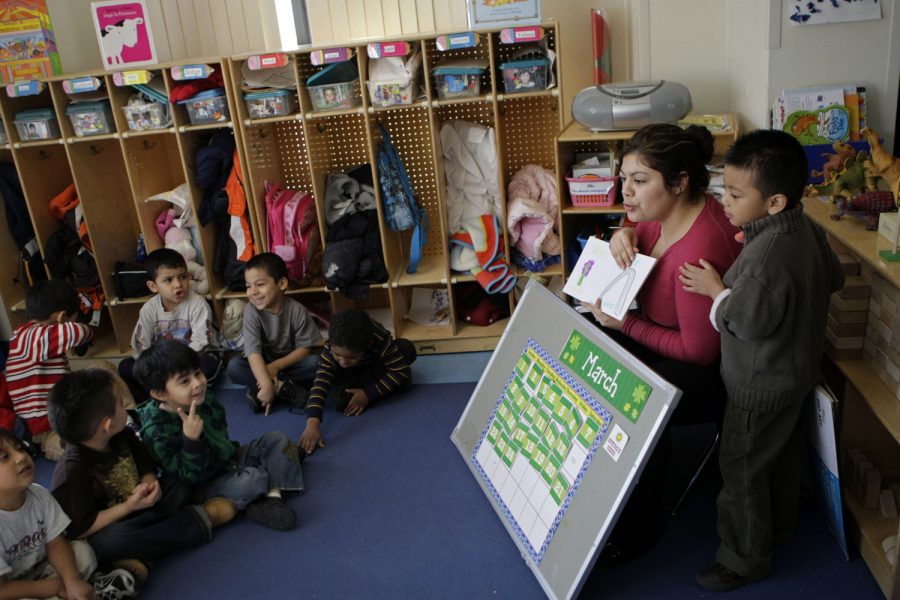More opportunity for students in dual language classrooms, experts say
Dual language classrooms provide native Spanish-speaking students with the opportunity to learn English while still speaking in their native tongue.
Gustavo Guzman, 4, right, leans on his teacher, Janeth Medellin as she tests her students on the months of the year in English and Spanish, in her pre-K class at Casa Infantil in the Logan Square neighborhood, March 25, 2009, in Chicago, Illinois. (José M. Osorio/Chicago Tribune/MCT)
August 23, 2018
West Liberty and Marshalltown School Districts further developed their dual-language programs in a University of Iowa College of Education seminar for teachers in July.
The seminars focused on how to teach English to non-native English speakers in a bilingual classroom setting.
Dual-language classrooms provide many benefits to students through the daily use of both languages, said David Cassels Johnson, a UI associate professor of education and linguistics.
The dual-language classrooms allow non-English speakers to learn English in the same environment as students who speak English.
“It’s clear in the [education] field that bilingual classrooms help Spanish-speaking children to learn English as well as allow non-Spanish speaking students to learn Spanish,” Johnson said.
Dual-language programs value linguistic and cultural differences that the students bring to the classroom, Johnson said. Teachers can bring different cultures into the classroom and apply it to lessons, he said.
He also said research shows dual-language education is the most effective way for students to learn English with their peers.
Half of a school day is taught in English and the other half in the students’ native language in dual-language classroom, he said. At West Liberty and Marshalltown, Spanish is the second language.
Lisa Wymore, a consultant for English-language learners through the Area Education Association, said the programs build students’ linguistic and literacy skills while teaching them to interact with and learn about people of different cultures.
The programs try to have a balanced number of English-language learners and English speakers in classrooms, she said. Language-arts lessons are taught in English and Spanish, which allows English-language learners to strengthen their Spanish-speaking abilities in class while still learning English.
“The challenge of these classrooms is that they’re sometimes misunderstood,” Wymore said. “Some people don’t understand the purpose of the classrooms and that they focus on both languages.”
Dual-language classrooms are less common programs in schools compared with programs for English-language learner, said Ismenia Castelan, a UI graduate and English language-learner teacher at Columbus Junction Middle School.
Both English and Spanish are taught in the classroom in dual-language programs, whereas English language-learner programs have specialized teachers who come in to help students learning English or work with the students one-on-one.
Castelan said in English language-learner programs, teachers promote native language speaking to their students but also emphasize the students need to learn English in order to navigate the United States. In dual-language classrooms, they emphasize the importance of being bilingual.
The stressed importance of learning both languages allows students of different backgrounds to have a diverse classroom experience filled with unique learning opportunities, she said.
“New English speakers sometimes feel ashamed, because they don’t know much English,” Castelan said. “In the dual-language programs, they are encouraged to use the speaking abilities they already have.”



